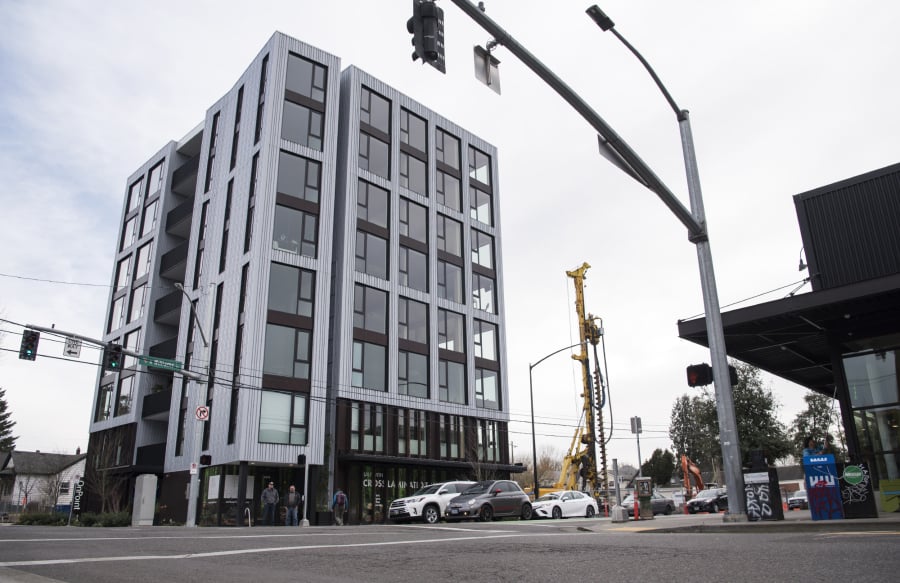In its brief existence, The Waterfront Vancouver has offered an urban development few could have thought possible in Vancouver.
Apartments, condominiums, restaurants, a hotel, a park and signature architectural details have emerged along the Columbia River, inspiring confidence that more of the same can be expected on the dozen or so remaining blocks.
It makes sense then that one of those blocks may one day be the home of a construction style that is the hot new thing.
The Trestle, as it’s been named, would be built on the development’s Block 14 with mass timber construction, employing all-wood structural components and rising to a height that would make it the tallest wood building in the United States, at least for now. The apartment house would be the latest in a line of other wood structures built by its Portland-based architecture firm.
The building method has strong advocates, led by two of the world’s most influential institutions in forestry. At Oregon State University, one professor extols mass timber construction’s appeal but warns against what he calls hype. And at Washington State University in Pullman, another professor says, “I haven’t seen this much excitement over timber in my whole career.”
The Canyons
Emily Dawson is standing on the seventh floor of a building overlooking the construction site for The Canyons, a 110,000-square-foot mixed-use project at 3450 N. Williams Ave. in Portland. That project, due to be completed by the end of this year, is expected to share some characteristics with Vancouver’s Trestle, chiefly that it is an apartment building designed with retired or soon-to-be retired residents in mind.
Dawson is lead architect for The Canyons, a project that, like The Trestle, will use mass timber construction. It’s a method that clearly is a favorite of hers and her employer, Portland’s Kaiser Group and its in-house design firm, Path Architecture.
“It’s beautiful,” Dawson says, who is also lead architect on The Trestle. “And it’s so fun to build with a structural material you can expose, that looks really good, that gives you that natural feel, that gives you that connection with nature. That’s why we’re really attracted to it.”
Dawson was surrounded by an example of mass timber construction. She was standing in an unsold unit of Carbon12, an eight-story condominium tower that Path Architecture and Kaiser Group completed in January 2018. This particular 1,578-square-foot unit – offered for $1.115 million – displays beefy beams with multiple wood layers that have been glued together, with visible wood grain striations.
Not visible are the cross-laminated timber panels that provide structure for the floors and walls. CLT, as it’s known, has been the star of the all-wood hoopla as it has arrived relatively recently on the U.S. construction scene. Wood is glued in layers and compressed to form structural panels — similar to plywood, but on a bigger scale. Another component, glulam (glued and laminated) beams, have been around for about 100 years. Together, CLT and glulam fall under the umbrella label of mass timber construction.
Path Architecture and Kaiser Group value mass timber not for its looks alone. It’s functional, too. A mass timber building project’s parts arrive at a job site cut to exact specifications — including grooves for utility lines. With each part numbered, the structure is swiftly assembled, Dawson says, cutting months off a construction schedule.
“There’s enough of a schedule advantage that it actually works out cost-wise,” Dawson says. “That’s why we only build in mass timber.”
Mass timber’s environmental attributes give it the edge over traditional tall building construction, she says, pointing to concrete’s carbon footprint while trees absorb carbon.
“And trees are renewable,” adds Kristin Slavin, of Path Architecture and Kaiser Group, who designed Carbon12. “Those trees can be replanted and regrown … so it’s definitely more of a full life cycle material than just extracting resources and turning them into buildings.”
Structurlam, a British Columbia company regarded as a world leader in mass timber production, supplied the CLT panels, glulam beams and other materials for Carbon12’s construction.
“The positive surprise was that it actually worked,” said Slavin of her first experience in mass timber design. “It actually was perfect on site. We didn’t have to cut anything except for two beams on site, and those were preplanned.”
Mass timber veteran
As associate director of the Tall Wood Institute at Oregon State University, Iain Macdonald is particularly evangelical about mass timber construction. Before joining the institute in 2016, Macdonald led the Centre for Advanced Wood Products at the University of British Columbia for 10 years.
The Tall Wood Institute — a collaboration of OSU’s College of Forestry, College of Engineering and the University of Oregon School of Architecture and Allied Arts — bills itself as the nation’s only research collaborative that focuses exclusively on the advancement of structural wood products.
That said, Macdonald is wary of the hype surrounding mass timber construction.
“People get very excited by these new wood buildings,” he says. “It has resulted in misconceptions.”
One of them is that CLT can use smaller diameter trees, the type that are deemed unworthy for dimensional timber. While that’s true, Macdonald said the trees now supplying the mass timber producers are Douglas fir or other trees that typically are cut for lumber.
But the potential for wider use of mass timber construction for building taller than six stories in the U.S. is no exaggeration, Macdonald says. Recent building code changes acknowledge the strength, safety and durability of mass timber construction. What’s needed now, he said, is more wood products companies making CLT and other mass timber material.
As it turns out, Oregon State University was the site of a mass timber construction misstep on its Corvallis campus.
Construction on Peavy Hall was halted last March after a CLT panel collapsed. An investigation found defects in CLT panels produced at DR Johnson Lumber Co. in Riddle, Ore. Several stories were published about the failure. Construction resumed last July and completion of the 80,000-square-foot building, the home of OSU’s forestry school, is expected by the end of the year.
“People screw up with steel beams and manufacturing concrete, as well,” said Brian Libby, a Portland architecture critic and writer who speaks positively about CLT. Libby praised the construction for its aesthetic charms as well as better resistance to earthquake damage than steel and concrete.
“Most people inherently like being in a wood building,” Libby said. “It’s sort of the future and past. CLT is this technology that allows us to do things we hadn’t thought possible. There will be wood skyscrapers.”
Oregon State, meanwhile, was undeterred in its mass timber vision. The nearby 15,000-square-foot Advanced Wood Products Lab, located near Peavy Hall, will be completed in August, having used concrete and glulam beams in its construction as well as a new product: mass plywood panels, manufactured at Freres Lumber Co., Inc. in Lyons, Ore., university spokesman Steve Clark said. And an academic building at OSU’s Bend campus, still in its design phase, is expected to use mass timber construction materials.
Time for a resurgence?
The United States is following a mass timber path that Europe and then Canada already have blazed, said Don Bender, director of Washington State University’s Composite Materials and Engineering Center.
Mass timber construction in tall buildings has been underway in Europe for up to 40 years, primarily because of a different approach to design processes and innovation compared with the U.S., said Bender, the Weyerhaeuser Distinguished Professor in the Department of Civil and Environmental Engineering.
Canada has been using mass timber building for at least 15 years, partly because the nation allows easier access to damaged but salvageable timber, Bender said.
But, he said he has high hopes that the U.S. construction industry will get up to speed with Europe and Canada.
He noted that two engineered wood factories are opening in Washington next month. Katerra Inc. is opening a 250,000-square-foot plant in Spokane Valley, The Spokesman-Review reported. The other engineered wood products company – Vaagen Timbers LLC – is expected to open in Colville.
The Washington State Building Code Council provided an assist to the industry last year, approving code changes that will allow for the structural use of mass timber in buildings as tall as 18 stories. The change made Washington the first state to allow tall mass timber buildings into its building code, without pursuing an alternate method.
Architects are taking notice, Bender said.
“Architects always loved wood as a building material,” he says, “but for a lot of the buildings they weren’t permitted to use wood.”
Next week, the International Mass Timber Conference will be held at the Oregon Convention Center in Portland. Up to 1,600 people are expected to attend, the largest contingent in the event’s four-year history, attracting participants from nearly 30 countries.
“My whole career, I’ve worked in timber engineering … teaching students (and) researching,” Bender says, and “I haven’t seen this much excitement over timber in my whole career. It’s wonderful news. It’s wonderful news for rural communities and economic development. It’s wonderful for reducing greenhouse gases.”
The Trestle
As principal architect on The Trestle, Dawson is leading the due diligence for Kaiser Group and Path Architecture. If all goes as expected, the 16-story, 185-foot-high, 110-unit apartment building would be completed in 2023. Early conversations with city of Vancouver development officials have been productive, she says, and all signs point to a property purchase from Gramor Development and eventual construction.
But will the U.S. Forest Service approve a grant to Path/Kaiser to offset research and design costs? Will the city of Vancouver relent on its requirement that the developer set aside a parking space for every unit? Will the building height satisfy FAA regulations? Will the designers have made the right choice to eschew underground parking because of intruding Columbia River water that has plagued waterfront projects?
And what of Dawson’s vision of electric scooters, car share services, pedestrians and bicycles populating the waterfront transportation scene, as well as her position that light rail should sail over the river into downtown Vancouver sooner rather than later?
Dawson concedes she hasn’t spent much time in Vancouver.
But she’s spent enough time looking at The Waterfront Vancouver’s Block 14 and at sketches of The Trestle, which would tower over BNSF Railway tracks, to know it’s got the right name.
“The interesting thing with train trestles is that a lot of them are built out of wood,” she says. “They’re exposed and outside and a lot of them have been around for 100 years or more. They’re really a great symbol of the resiliency and durability and strength of wood.”




